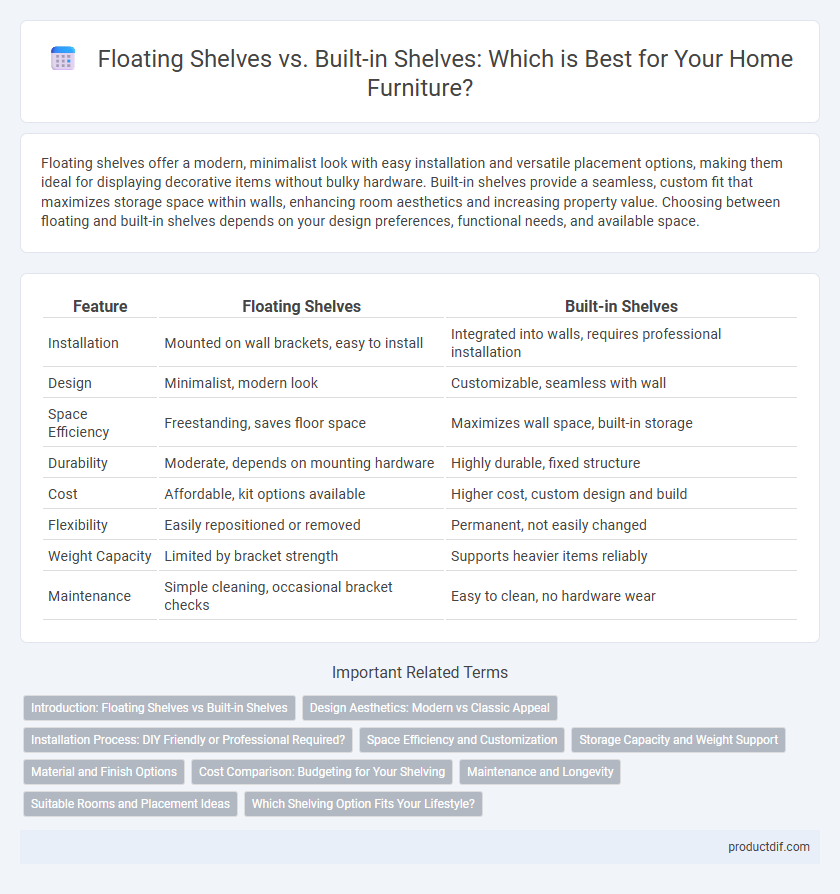Floating shelves offer a modern, minimalist look with easy installation and versatile placement options, making them ideal for displaying decorative items without bulky hardware. Built-in shelves provide a seamless, custom fit that maximizes storage space within walls, enhancing room aesthetics and increasing property value. Choosing between floating and built-in shelves depends on your design preferences, functional needs, and available space.
Table of Comparison
| Feature | Floating Shelves | Built-in Shelves |
|---|---|---|
| Installation | Mounted on wall brackets, easy to install | Integrated into walls, requires professional installation |
| Design | Minimalist, modern look | Customizable, seamless with wall |
| Space Efficiency | Freestanding, saves floor space | Maximizes wall space, built-in storage |
| Durability | Moderate, depends on mounting hardware | Highly durable, fixed structure |
| Cost | Affordable, kit options available | Higher cost, custom design and build |
| Flexibility | Easily repositioned or removed | Permanent, not easily changed |
| Weight Capacity | Limited by bracket strength | Supports heavier items reliably |
| Maintenance | Simple cleaning, occasional bracket checks | Easy to clean, no hardware wear |
Introduction: Floating Shelves vs Built-in Shelves
Floating shelves offer a sleek, modern aesthetic with visible supports hidden beneath the shelf, creating an illusion of weightlessness ideal for minimalist spaces. Built-in shelves are integrated into walls, providing robust storage that maximizes space while blending seamlessly with architectural elements. Both options cater to different design preferences and functional needs, emphasizing style versus permanence.
Design Aesthetics: Modern vs Classic Appeal
Floating shelves offer a sleek, modern appeal with clean lines and minimalistic design, enhancing contemporary interiors by creating an airy, uncluttered look. Built-in shelves, by contrast, provide a classic, timeless aesthetic with integrated craftsmanship that often features detailed molding and wood finishes, complementing traditional or transitional decor. The choice between floating and built-in shelves significantly influences the room's overall style, balancing openness against architectural permanence.
Installation Process: DIY Friendly or Professional Required?
Floating shelves offer a DIY-friendly installation process with simple wall brackets and anchors, making them ideal for renters or quick upgrades. Built-in shelves require professional expertise due to complex carpentry, wall modifications, and precise measurements to ensure seamless integration. Choosing between them depends on skill level, budget, and desired permanence in furniture design.
Space Efficiency and Customization
Floating shelves maximize space efficiency by occupying minimal wall area and creating a clean, open look, ideal for small rooms or tight spaces. Built-in shelves offer superior customization, seamlessly integrating with existing architecture to optimize storage and display options tailored to specific dimensions and design preferences. Both solutions enhance organization, but floating shelves emphasize versatility and minimalism, while built-ins prioritize tailored fit and increased storage capacity.
Storage Capacity and Weight Support
Floating shelves offer versatile storage with a sleek design but typically support less weight compared to built-in shelves, making them ideal for lighter items like books and decorative pieces. Built-in shelves are anchored directly into wall studs, providing superior weight support and maximizing storage capacity for heavy items such as large books, electronics, and storage boxes. The choice between floating and built-in shelves depends on the need for load-bearing strength and the amount of storage space required.
Material and Finish Options
Floating shelves often feature materials like solid wood, MDF, and metal, allowing for versatile finish options such as painted, stained, or natural wood grain to match modern or minimalist decor. Built-in shelves typically use plywood or hardwood with customizable finishes including lacquer, veneer, or laminate, providing a seamless integration with walls and a polished, permanent aesthetic. Both types offer durable materials and finishes, but built-in shelves deliver a more tailored, cohesive look ideal for enhancing architectural details.
Cost Comparison: Budgeting for Your Shelving
Floating shelves typically cost less than built-in shelves due to lower materials and installation expenses, ranging from $20 to $150 per shelf compared to $200 to $600 or more for built-ins. Labor costs for built-in shelving can significantly increase the overall budget, often requiring professional carpentry and longer installation times. When budgeting, consider the long-term value, durability, and potential customization of built-in shelves versus the affordability and ease of installation offered by floating shelves.
Maintenance and Longevity
Floating shelves require minimal upkeep with occasional dusting and checking for wall anchor stability, while built-in shelves demand more intensive maintenance like repainting or refinishing to preserve their structural integrity. Floating shelves, typically made from composite materials or lightweight wood, are less durable over time compared to built-in shelves constructed from solid wood or plywood, which offer enhanced longevity. Proper installation and regular care directly influence the lifespan of both floating and built-in shelving solutions in residential settings.
Suitable Rooms and Placement Ideas
Floating shelves excel in small rooms like bathrooms and kitchens, offering versatile placement above sinks, toilets, or countertops without occupying floor space. Built-in shelves are ideal for living rooms and home offices, seamlessly integrated into walls around fireplaces, desks, or media centers, maximizing storage while enhancing room aesthetics. Both options provide stylish organization but differ in installation complexity and spatial impact tailored to specific room functions.
Which Shelving Option Fits Your Lifestyle?
Floating shelves offer a modern, minimalist look ideal for small spaces or renters needing flexible storage, while built-in shelves provide permanent, custom storage solutions that enhance home value and maximize wall space. Consider your lifestyle needs: floating shelves suit those seeking easy installation and versatility, whereas built-in shelves are perfect for homeowners desiring durability and seamless integration with existing decor. Evaluate space constraints, design preferences, and long-term storage requirements to choose the optimal shelving option.
Floating shelves vs Built-in shelves Infographic

 productdif.com
productdif.com